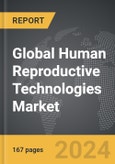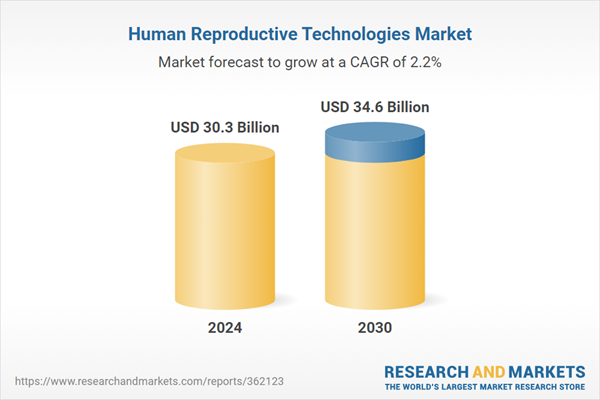The global market for Human Reproductive Technologies was valued at US$30.3 Billion in 2024 and is projected to reach US$34.6 Billion by 2030, growing at a CAGR of 2.2% from 2024 to 2030. This comprehensive report provides an in-depth analysis of market trends, drivers, and forecasts, helping you make informed business decisions. The report includes the most recent global tariff developments and how they impact the Human Reproductive Technologies market.
In terms of technological innovation within this sector, assistive reproductive technologies (ART) like in vitro fertilization (IVF) have seen notable developments. The integration of intellectual property (IP) into ART, especially with emerging technologies such as in vitro gametogenesis (IVG), is reshaping the landscape. IVG, which involves reprogramming cells to develop into sperm or eggs, represents a significant shift from traditional methods by potentially allowing genetic selection and modification previously unattainable. The approach to IP in this realm has evolved from a collaborative, open-sharing model to a more competitive one, with researchers and companies increasingly seeking to secure patents. This shift is influenced by the substantial financial potential of IVG, although it also brings complex ethical and regulatory challenges that could affect the scope and viability of patentable material in reproductive technologies.
The expansion of the human reproductive technologies market is propelled by several key drivers. Innovations such as intracytoplasmic sperm injection (ICSI) and preimplantation genetic diagnosis (PGD) continue to revolutionize fertility treatments, enhancing their effectiveness and broadening their appeal. The growing societal acceptance of ART has reduced stigma and increased usage, particularly among diverse family structures, including single parents by choice and LGBTQ+ families. Additionally, the expansion of healthcare financing options, increased commercial investments, and supportive legislative changes have made these technologies more accessible and popular. Moreover, advancements in genetic screening and the trend toward personalized medicine are enabling more tailored and effective fertility treatments. Collectively, these factors are fostering a dynamic market environment where reproductive technologies are not only advancing in capability but also becoming more integrated into societal frameworks and expectations, significantly impacting how future generations are conceived and born.
Segments: Technology (Contraceptive Drugs & Devices, Infertility Treatment).
Geographic Regions/Countries: World; United States; Canada; Japan; China; Europe (France; Germany; Italy; United Kingdom; Spain; Russia; and Rest of Europe); Asia-Pacific (Australia; India; South Korea; and Rest of Asia-Pacific); Latin America (Argentina; Brazil; Mexico; and Rest of Latin America); Middle East (Iran; Israel; Saudi Arabia; United Arab Emirates; and Rest of Middle East); and Africa.
The analysts continuously track trade developments worldwide, drawing insights from leading global economists and over 200 industry and policy institutions, including think tanks, trade organizations, and national economic advisory bodies. This intelligence is integrated into forecasting models to provide timely, data-driven analysis of emerging risks and opportunities.
Global Human Reproductive Technologies Market - Key Trends and Drivers Summarized
The human reproductive technologies market is experiencing substantial growth due to a confluence of demographic shifts, technological advancements, and evolving societal norms. This sector includes a variety of treatments and technologies designed to address fertility and reproduction challenges, with increasing demand driven by higher infertility rates and shifting trends towards later family planning. Factors such as lifestyle changes, delayed childbearing, and higher consumption of substances affecting fertility contribute to the growing prevalence of infertility, prompting greater reliance on reproductive technologies. Medical advancements are making these technologies more accessible and effective, enhancing their adoption across the globe. In particular, the contraceptive segment holds a significant market share due to the ease of use, widespread availability, and simple administration of oral contraceptives, further supported by government initiatives aimed at preventing unplanned pregnancies and promoting sexual health.In terms of technological innovation within this sector, assistive reproductive technologies (ART) like in vitro fertilization (IVF) have seen notable developments. The integration of intellectual property (IP) into ART, especially with emerging technologies such as in vitro gametogenesis (IVG), is reshaping the landscape. IVG, which involves reprogramming cells to develop into sperm or eggs, represents a significant shift from traditional methods by potentially allowing genetic selection and modification previously unattainable. The approach to IP in this realm has evolved from a collaborative, open-sharing model to a more competitive one, with researchers and companies increasingly seeking to secure patents. This shift is influenced by the substantial financial potential of IVG, although it also brings complex ethical and regulatory challenges that could affect the scope and viability of patentable material in reproductive technologies.
The expansion of the human reproductive technologies market is propelled by several key drivers. Innovations such as intracytoplasmic sperm injection (ICSI) and preimplantation genetic diagnosis (PGD) continue to revolutionize fertility treatments, enhancing their effectiveness and broadening their appeal. The growing societal acceptance of ART has reduced stigma and increased usage, particularly among diverse family structures, including single parents by choice and LGBTQ+ families. Additionally, the expansion of healthcare financing options, increased commercial investments, and supportive legislative changes have made these technologies more accessible and popular. Moreover, advancements in genetic screening and the trend toward personalized medicine are enabling more tailored and effective fertility treatments. Collectively, these factors are fostering a dynamic market environment where reproductive technologies are not only advancing in capability but also becoming more integrated into societal frameworks and expectations, significantly impacting how future generations are conceived and born.
Report Scope
The report analyzes the Human Reproductive Technologies market, presented in terms of units. The analysis covers the key segments and geographic regions outlined below.Segments: Technology (Contraceptive Drugs & Devices, Infertility Treatment).
Geographic Regions/Countries: World; United States; Canada; Japan; China; Europe (France; Germany; Italy; United Kingdom; Spain; Russia; and Rest of Europe); Asia-Pacific (Australia; India; South Korea; and Rest of Asia-Pacific); Latin America (Argentina; Brazil; Mexico; and Rest of Latin America); Middle East (Iran; Israel; Saudi Arabia; United Arab Emirates; and Rest of Middle East); and Africa.
Key Insights:
- Market Growth: Understand the significant growth trajectory of the Contraceptive Drugs & Devices segment, which is expected to reach US$22.0 Billion by 2030 with a CAGR of a 2.5%. The Infertility Treatment segment is also set to grow at 1.7% CAGR over the analysis period.
- Regional Analysis: Gain insights into the U.S. market, valued at $8.2 Billion in 2024, and China, forecasted to grow at an impressive 3.9% CAGR to reach $6.6 Billion by 2030. Discover growth trends in other key regions, including Japan, Canada, Germany, and the Asia-Pacific.
Why You Should Buy This Report:
- Detailed Market Analysis: Access a thorough analysis of the Global Human Reproductive Technologies Market, covering all major geographic regions and market segments.
- Competitive Insights: Get an overview of the competitive landscape, including the market presence of major players across different geographies.
- Future Trends and Drivers: Understand the key trends and drivers shaping the future of the Global Human Reproductive Technologies Market.
- Actionable Insights: Benefit from actionable insights that can help you identify new revenue opportunities and make strategic business decisions.
Key Questions Answered:
- How is the Global Human Reproductive Technologies Market expected to evolve by 2030?
- What are the main drivers and restraints affecting the market?
- Which market segments will grow the most over the forecast period?
- How will market shares for different regions and segments change by 2030?
- Who are the leading players in the market, and what are their prospects?
Report Features:
- Comprehensive Market Data: Independent analysis of annual sales and market forecasts in US$ Million from 2024 to 2030.
- In-Depth Regional Analysis: Detailed insights into key markets, including the U.S., China, Japan, Canada, Europe, Asia-Pacific, Latin America, Middle East, and Africa.
- Company Profiles: Coverage of players such as Ansell Healthcare LLC, Ansell Ltd., Apothecus Pharmaceutical Corporation, Bayer AG, Cipla Ltd. and more.
- Complimentary Updates: Receive free report updates for one year to keep you informed of the latest market developments.
Some of the 12 companies featured in this Human Reproductive Technologies market report include:
- Ansell Healthcare LLC
- Ansell Ltd.
- Apothecus Pharmaceutical Corporation
- Bayer AG
- Cipla Ltd.
- Ferring Pharmaceuticals, Inc.
- Indian Drugs & Pharmaceuticals Ltd.
- Janssen Pharmaceuticals, Inc.
- Johnson & Johnson
- Lupin Ltd.
- Mankind Pharma Ltd.
- Mapa GmbH
- Merck & Co., Inc.
- Merck KGaA
- Pfizer, Inc.
- The Female Health Company (FC2)
- T-MARC Tanzania
Tariff Impact Analysis: Key Insights for 2025
Global tariff negotiations across 180+ countries are reshaping supply chains, costs, and competitiveness. This report reflects the latest developments as of April 2025 and incorporates forward-looking insights into the market outlook.The analysts continuously track trade developments worldwide, drawing insights from leading global economists and over 200 industry and policy institutions, including think tanks, trade organizations, and national economic advisory bodies. This intelligence is integrated into forecasting models to provide timely, data-driven analysis of emerging risks and opportunities.
What’s Included in This Edition:
- Tariff-adjusted market forecasts by region and segment
- Analysis of cost and supply chain implications by sourcing and trade exposure
- Strategic insights into geographic shifts
Buyers receive a free July 2025 update with:
- Finalized tariff impacts and new trade agreement effects
- Updated projections reflecting global sourcing and cost shifts
- Expanded country-specific coverage across the industry
Table of Contents
I. METHODOLOGYII. EXECUTIVE SUMMARY2. FOCUS ON SELECT PLAYERSIII. MARKET ANALYSISIV. COMPETITION
1. MARKET OVERVIEW
3. MARKET TRENDS & DRIVERS
4. GLOBAL MARKET PERSPECTIVE
UNITED STATES
CANADA
JAPAN
CHINA
EUROPE
FRANCE
GERMANY
ITALY
UNITED KINGDOM
SPAIN
RUSSIA
REST OF EUROPE
ASIA-PACIFIC
AUSTRALIA
INDIA
SOUTH KOREA
REST OF ASIA-PACIFIC
LATIN AMERICA
ARGENTINA
BRAZIL
MEXICO
REST OF LATIN AMERICA
MIDDLE EAST
IRAN
ISRAEL
SAUDI ARABIA
UNITED ARAB EMIRATES
REST OF MIDDLE EAST
AFRICA
Companies Mentioned (Partial List)
A selection of companies mentioned in this report includes, but is not limited to:
- Ansell Healthcare LLC
- Ansell Ltd.
- Apothecus Pharmaceutical Corporation
- Bayer AG
- Cipla Ltd.
- Ferring Pharmaceuticals, Inc.
- Indian Drugs & Pharmaceuticals Ltd.
- Janssen Pharmaceuticals, Inc.
- Johnson & Johnson
- Lupin Ltd.
- Mankind Pharma Ltd.
- Mapa GmbH
- Merck & Co., Inc.
- Merck KGaA
- Pfizer, Inc.
- The Female Health Company (FC2)
- T-MARC Tanzania
Table Information
| Report Attribute | Details |
|---|---|
| No. of Pages | 167 |
| Published | April 2025 |
| Forecast Period | 2024 - 2030 |
| Estimated Market Value ( USD | $ 30.3 Billion |
| Forecasted Market Value ( USD | $ 34.6 Billion |
| Compound Annual Growth Rate | 2.2% |
| Regions Covered | Global |









